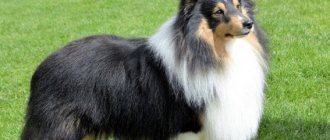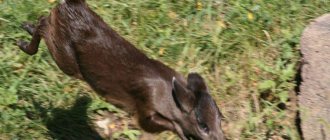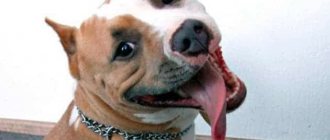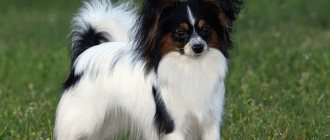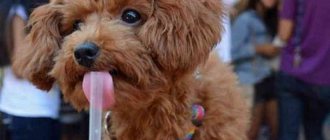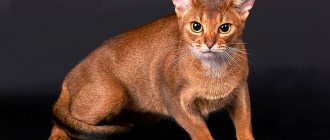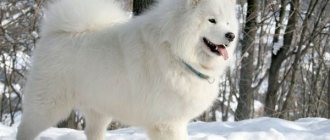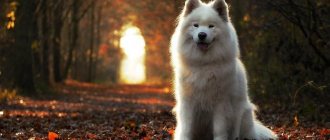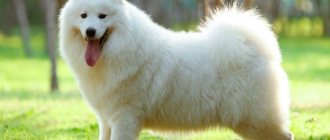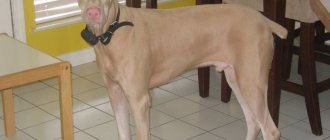- Pets
- >>
- Dog breeds
* Here is a photo of a typical representative of the Samoyed dog breed . You can send us photos of your animals by email, and we will post them on the website. Don't forget to send your pet's name.
Other breed names:
Samoyed, Samoyed Husky, Samoyed Spitz, Sammi
Video
* We invite you to watch a video about the Samoyed dog . In fact, in front of you is a playlist in which you can select and watch any of 20 videos about a given dog breed by simply clicking on the button in the upper right corner of the window. In addition, the material contains quite a lot of photos. By looking at them you can find out what a Samoyed dog looks like.
In this article:
|
History of the origin of Samoyed dogs
The history of the origin of Samoyed dogs is not known with certainty. Even regarding their name, there is disagreement. According to the first version, the name of the dogs comes from a similar name of the people who became the progenitors of the modern Nenets. Samoyed, in this case, comes from the word “samoyed”, that is, “self-centered”, fixated on oneself. This can be justified by the territorial isolation of the Nenets people.
Another name is literal, that is, literally “it goes by itself.” Samoyeds, indeed, were used as sled dogs, which independently rolled sleds and unquestioningly obeyed their owner. There is a version that the snow-white dogs were not visible in the snow, so it seemed that the team drawn by the Samoyeds was driving itself.
There is another option about the origin of the name Samoyeds - “saam-jedna”, which literally means “land of the Sami people”. Samoyeds are dogs bred by the Nenets people for their needs. Smart dogs had to carry sleighs, loads, provide warmth in cold weather, protect herds of deer and follow people.
According to one version, Samoyeds were brought to Europe by the Englishman Joseph Wiggens, who was involved in trade relations with Siberia, although this fact has not been confirmed by experts. The history of the Samoyed breed goes back centuries, so it is very difficult to reliably establish the origin of the breed, and there is almost no evidence of its existence over time.
Another version says that the dogs came to England in 1889 thanks to Ernest Scott, who organized a nursery for the strange breed. Thanks to their qualities, Samoyeds began to gain popularity in Europe. Even King Edward the Seventh had Samoyed Laikas who occupied a privileged position.
In 1920, the first Samoyed association in England was organized, thereby establishing breed standards. Much later, the dogs came to the USSR - only by 1989 were they exported from Denmark. Today, Samoyeds are one of the most popular dog breeds that have spread throughout the world.
Samoyed dog - description of the breed
The Samoyed husky has two breed varieties: bear and wolf. They differ in minor constitutional parameters. The wolf Samoyed is more elongated and lighter, with a narrow head and a long body. The bear subtype has a shorter, powerful body and a shorter and flatter head.
Interesting fact: The breed standard was described back in 1988 by the English Kennel Club. Adult male Samoyeds should weigh between 25 and 30 kg, while adult females weigh less, between 17 and 23 kg. Height at the withers is 53-55 cm. The length of the body should not exceed the height of the dog by more than 5 percent, that is, the dog is almost “square”.
The Samoyed Laika's skull is wedge-shaped, quite powerful and dense. There is a large distance between the ears with smooth short hair. The muzzle is short, tapering towards the nose. Samoyeds have clearly defined black lips that form a smile. The eyes are almond-shaped, set wide apart, have a black rim, and slightly pointed at the corners. The nose of the Samoyed husky is black, the lobe is developed. Sometimes the nose can be pink-red or brown, but a black outline is required.
The Samoyed's ears are of medium length, slightly rounded at the end, covered with thick hair inside and out, and always erect. A scissor bite is required for this breed. The neck is strong, short, and has a slight bend.
The Samoyed has a strong, straight back, which is slightly longer in females than in males. The loin is pronounced, muscular, the pelvis is strong and slightly inclined. Wide and deep chest. The front legs are of medium length, set at the edges of the chest, the toes pressed tightly together. The hind legs are slightly laid back, very strong and muscular, set parallel to each other. The tail is long and very fluffy; when the dog is in a good mood, it curls slightly over the back or to the side.
Popular colors of Samoyed dogs
The wool of Samoyed huskies is unique in its kind. This is an arctic, thick and fluffy fur designed for very low temperatures. The Samoyed's undercoat is thick, more like goose down. The center coat is long, straight, but soft. Around the neck and over the shoulders there is a wide fluffy collar that forms a ring.
The dog's head and paws are covered with even, slightly shorter hair. It is very soft and smooth, in contrast to the rougher cover of the body. The hind legs, particularly the thighs, are covered with a fluffy layer that resembles pants. Even between the fingers, which are pressed tightly together, there is dense fur.
The color of Samoyeds, at first glance, is very monotonous - white. In fact, dog experts recognize several colors of Samoyeds, which are almost impossible to distinguish from each other with the naked eye.
Namely, these are the colors:
- Matte white. This is a white textured wool without shimmer;
- Glossy white. The fur is more hollow, which is why the fur shimmers in the sun;
- White with a blue tint. Cooler shade;
- White with a red tint. In the light, the dog resembles a small light;
- Light fawn color - a barely noticeable red tint of the Samoyed.
Many dog hairs have a silvery tint to them, which gives the dog a slightly sparkly appearance. This color is due to the living conditions of Samoyed dogs - harsh Arctic regions, where they blended with the snow and let sunlight through them.
Character and habits of Samoyed dogs
Samoyed huskies are very friendly and affectionate dogs that have an affable, easy-going character. They are good emotional companions, fit easily into families and quickly gain popularity. They are ready to communicate, quickly find a common language with people and behave very delicately. At the same time, they do not impose their attention, although they can become depressed if there is not enough communication with them.
Samoyeds are kind not only to family members, but also to everyone around them. They are ready to get to know other people and animals, never show unreasonable aggression, are open to communication and friendly. If its owner is constantly busy, then the Samoyed will look for friends on his own - a strong pack instinct prompts him to do this.
Samoyeds are easy to train because they are quite intelligent and do not have the stubbornness associated with some dog breeds. It is extremely rare for dogs to show willfulness - in this case, a qualified trainer will find an approach to them.
Interesting fact: Samoyeds are very active because they have the hunting instinct. This makes Samoyed huskies playful animals that are ready to run a lot and “hunt” for impromptu prey. Thanks to these character traits, Samoyeds get along well with children - they will never bite or offend a child, and if they don’t like something, they will simply try to get away from the irritant.
Samoyeds can be watchdogs, but you should not have one for this purpose. First of all, these are companion dogs that are aimed at communicating with people and accompanying a person emotionally, and not at any practical activities.
Buying a dog
You can buy a Samoyed at a nursery or from private breeders. In this case, you need to pay attention to the reputation of the nursery, read reviews and make sure that all the necessary documents are available. When visiting a place where little huskies are raised, you need to pay attention to the living conditions, cleanliness and smell in the room (especially if it is an apartment).
The cost of Samoyeds is virtually no different in nurseries and private owners. It depends to a large extent on the pedigree of the animal, its compliance with all the characteristics of the breed and health. For example, a dog whose parents have all kinds of awards, and who have already produced more than one healthy offspring, can cost from 45,00 rubles and above , while puppies from the first litter or with minor defects of the breed can be bought for 15-20 thousand . Dogs that cost less than 15 thousand rubles are most likely not purebred, and may not be the size, color or character you need.
Interesting facts about Samoyed dogs
The Samoyed dog breed has been used for a variety of purposes. Transporting cargo and sleds is just one of the many tasks Samoyeds face. For example, Samoyeds were used to hunt both small game and large animals. They hunted walruses and even polar bears.
Samoyeds are good with children for a reason. For centuries, these dogs kept children warm with their warm fur and fussed with them when their parents had no time for it. In fact, Samoyed huskies served as “nannies.”
Due to the fact that people often slept with Samoyed huskies, they have a number of characteristics if a person takes them to sleep in his bed. For example, dogs lie motionless and are afraid to wake a person, and if they are going to leave or roll over, they do it very carefully.
Warm clothes can be made from Samoyed wool - mittens, hats, scarves and socks. This wool provides excellent warmth in winter. In this case, the hair does not need to be cut - it can be easily combed from the dog. Thanks to the peculiarities of the structure of the muzzle, Samoyed dogs always seem to smile. This makes the breed even more popular among breeders.
Samoyed dogs love to bark with or without reason. They bark, howl and squeal especially often when they lack attention - this makes Samoyeds one of the noisiest breeds. This behavior is justified by the fact that in the conditions of the far north, dogs regularly talk to each other using their voices - sound contractions have a warming effect on them.
It may seem that the Samoyed's coat requires a lot of care, daily washing and combing several times a day. Indeed, you need to take care of it carefully, but the structure of the Samoyed’s hair allows the coat to clean itself, and it repels most dirt.
A little history
Samoyeds, or Samoyeds (indigenous small peoples of Russia) lived about 3 thousand years ago. The nomadic nature of this population implied the presence of hardy mounts in snowy terrain. From them came a beautiful dog - the Samoyed Laika, intended for hunting and protection. Samoyeds helped herd livestock, guarded deer, took part in hunting, and even nursed and warmed children. These dogs are not afraid of severe frost.
The magnificent white coat at that time served to warm its owners. For the night, dogs were taken into the house and used as heating pads. Today this breed is quite rare, which is why the cost of Samoyeds is high.
Pros and cons of Samoyed dogs
Like any other dog, Samoyeds have their pros and cons that should be considered before getting a puppy of this breed.
The advantages of the Samoyed Laika include:
- Patience. Dogs are calm about children's games, even if a child pulls them by the tail and ears. Samoyeds are similarly patient with other animals who want to play with them. And if a medium-sized dog treats the Samoyed with aggression, the Samoyed Laika will prefer to gently ignore the bully;
- Communication skills. Samoyed huskies easily get along with other animals, make contact with people, are always ready to be near a person and enjoy communication;
- Calm character. Despite their sociability, Samoyeds are not hyperactive, but calm and measured;
- Samoyeds do not need special food - they are quite unpretentious in food;
- Samoyeds have strong immunity. They tolerate low temperatures especially well and can even live outside, rather than in a house or apartment.
The disadvantages of the Samoyed Laika include:
- These dogs need coat care more than any other. Samoyeds need to be washed and combed with special brushes, and also trimmed regularly;
- Samoyed dogs are very noisy. They love to bark, howl, squeal and make other sounds. Even during normal human interaction, they can communicate with their voices rather than with gestural signals, as many other dogs do;
- Samoyed huskies are bad guards - because of their friendliness, they can let strangers get very close. Likewise, they will not defend the owner by rushing at offenders;
- Samoyed Laika puppies are quite expensive.
Breeding Samoyed dogs
The female Samoyed husky begins to come into heat at 6-12 months. It occurs twice a year, but the duration is difficult to predict: from 7 to 28 days. All this time, the Samoyed husky can become pregnant. You should skip the first three heats, and after the third heat you can start mating.
There are three stages to the Samoyed husky's heat cycle. In the first few days, she does not accept male dogs, although they show interest in her. At the second stage, she is ready for mating - this is approximately 5-7 days after the start of estrus. In a week, she will again have a negative attitude towards attention from male dogs, and mating will be impossible.
Breeders allow mating of a Samoyed female only when she is at least 18 months old, and males - from 15 months. At this age, dogs can give birth to the most productive and healthy offspring. Since pregnancy is a huge stress for the body and a burden on the immune system and internal organs, only healthy and strong dogs should give birth.
The Samoyed Laika's pregnancy lasts about 63 days. During this time, the dog gains a lot of weight, becomes lazy and inactive. You need to walk it more often so that it does not develop heart problems, but in no case should you overload the dog so that it does not become overworked and stressed.
If the bitch refuses to eat or her body temperature rises, you need to contact a veterinarian. In the second half of pregnancy, slight green or yellow discharge is possible - this indicates that birth is near. A day before giving birth, the dog begins to fuss, whine and bark. Her breathing quickens, she often goes to the toilet, and is constantly thirsty.
Sometimes Samoyeds, like other dogs, experience false pregnancies. This is a situation where the dog has not been impregnated but is acting as if it is pregnant. She may even go into labor, but she will not produce puppies. In case of false pregnancy, you should consult a veterinarian. It is also advisable to entrust childbirth to a veterinarian, although Samoyed huskies are in good health and are quite capable of giving birth on their own.
Reproduction and lifespan
Samoyeds live up to 15 years, given proper living conditions. There are observations that dogs living in cold, natural conditions live longer than their counterparts from warm regions. In order for your dog to live long and happily, you need to see him at the veterinarian and regularly cleanse his body of parasites.
The bitch begins to heat at the age of one year. During this period, she will try to run away from home in order to find a male dog, but under no circumstances should this happen. She is not yet ready for pregnancy and childbirth, so she needs to wait for the third heat, when her body is formed.
It is not difficult to understand that a Samoyed has gone into heat: males begin to show attention to her. The bitch herself may not be interested in them at first. After about a week, she will show interest in male dogs, and at the end of the heat, she will drive them away from her quite aggressively. In total, estrus lasts about a week and a half.
Before mating, the dog needs to be strengthened: given vitamins and mineral complexes to protect the immune system and bones. The bitch is introduced to the male in advance: for a week or two they should just walk together. Mating occurs naturally when the dogs are well acquainted.
Pregnancy lasts two months. The dog is getting fat and doesn’t want to go for walks, but it still needs to be taken out for walks. As birth approaches, the Samoyed may develop a fever and may fuss and bark. The birth is best done with a veterinarian, although dogs are healthy enough to give birth on their own.
Samoyed puppies are active and inquisitive little white bundles. They grow quickly and begin to explore the world. Their mother keeps an eye on them, so there is no need to worry about them getting into trouble.
Samoyed husky with a puppy
Caring for Samoyed Dogs
Samoyeds are not particularly picky about their living conditions, especially if you buy a dog for a private home. They are able to live outside in an enclosure even in winter - and this option is more comfortable for dogs than living in an apartment. They are perfectly adapted to cold weather, but do not tolerate heat well. In addition, dogs require a lot of space.
If your Samoyed lives in an apartment, follow these guidelines:
- From an early age, the puppy must know its place. Organize a comfortable soft bed that will serve as a bed for the dog;
- The Samoyed should be brushed at least three times a week, preferably every day. For combing, hard brushes with sparse teeth are used, which are capable of combing out the thick undercoat. If you want the top layer of your dog’s coat to look great, you should also use a brush with natural bristles;
- After walks, you need to not only wash your paws, but also treat them with a soft cream - Samoyeds do not tolerate asphalt and hard surfaces very well;
- Ears and teeth should be cleaned, and nails should be trimmed as soon as they begin to click on the floor;
- You shouldn't bathe your Samoyed too often. As a rule, once every two weeks is enough, especially if the dog has not purposefully gotten dirty;
- Samoyeds should not be left alone for long periods of time as they may become depressed;
- The Samoyed should be walked twice every day, the walk should last at least one hour - dogs need to move a lot, play and run.
Although Samoyeds are very fluffy dogs, they do not require as much grooming as, for example, Afghan Hounds. You just need to comb them and wash them with special shampoos and conditioners.
Care and maintenance
It is not difficult to guess that Samoyed fur requires special care. This is true, but it is not recommended to wash your dog more than four times a year. For the conditions of the Far North this is not a problem - the dog does not get dirty from the snow, but for any other country the washing regime can be a problem, because the dog is not averse to swimming in a puddle. But Samoyeds have almost no smell, which is a definite plus.
Paws can be wiped with a damp towel after walks. The coat needs to be combed daily and tangles removed. Particular attention should be paid to scratching the armpits and the area under the tail. Dirt is removed in the same way: dust and dirt are combed out with a fine brush. It is not customary to cut Samoyeds, let alone shave them.
Walking is an essential part of Samoyed life. You need to walk two to three times a day for two hours. Active running, games, training - Samoyeds will be happy with any activity. After a run, the dog will not want to destroy the apartment. Otherwise, the Samoyed will vent his energy on the walls, the sofa, and equipment—whatever he gets his hands on.
Samoyeds can be kept in an apartment, but it is better to give them an enclosure near a private house. Both in winter and in summer, the dog will feel comfortable on a nearby walk. The main thing is to make sure that she does not overheat in the sun, and also provide her with a soft, warm bed.
The Samoyed Laika will become a devoted friend for all family members.
Diet of Samoyed dogs
As is the case with other dog breeds, Samoyeds can be fed homemade food or bought ready-made dry food - this is the choice of the dog owner. In any case, the diet must be balanced and healthy, otherwise the pet risks getting sick.
Only premium food is suitable for Samoyeds. It must be specially formulated for this breed, otherwise you again risk choosing an unbalanced food. If it is not possible to choose food for your breed, then give preference to food for large and active dogs.
To create a menu for a Samoyed yourself, you must consult with a specialist. Homemade food can be both beneficial and detrimental to your four-legged friend. It is necessary to strictly observe the ratio of all products so as not to harm the dog. If the food is chosen incorrectly, the dog becomes less active, his coat becomes dull, he is reluctant to walk and rarely goes to the toilet.
Products that are allowed for Samoyed dogs:
- Beef, chicken and turkey;
- Both sea and ocean fish, but without bones, raw or frozen;
- Suitable dairy products include low-fat kefir, yogurt, cottage cheese, yogurt and fermented baked milk;
- Samoyeds are very fond of vegetables, both raw and boiled;
- You can give simple fruits - apples and pears. Exotic fruits should not be given to Samoyeds. Fruits should not be a daily diet, but rather a reward for behavior or training.
Foods that should not be given to Samoyed dogs:
- They do not digest carrots well, so it is contraindicated for Samoyeds in large quantities;
- Whole milk is also prohibited for Samoyeds;
- Bakery;
- Sweet;
- Pasta;
- Fatty pork, lamb, fresh and steamed veal, boiled bones;
- Beets, potatoes;
- Sugar and salt, various spices;
- Sweets and chocolate.
Nutrition
Samoyed husky puppies who receive proper and balanced nutrition turn into beautiful dogs with healthy shiny coat, strong teeth and well-developed muscles. If the owner and his four-legged companion have chosen a natural type of feeding, then they should keep a list of prohibited foods in their head at all times.
These include fatty varieties of pork and lamb, steamed veal, absolutely any type of bones, including tubular bones, boiled beets and potatoes, spices such as salt, sugar, pepper and others, as well as sweets, especially chocolate. It is not advisable for your dog to try carrots in large quantities, milk, baked goods and pasta.
The list of recommended products includes poultry meat - chicken, turkey, and for children also minced meat, including offal. Sometimes you can give ocean or sea fish.
The acceptable cereals are rice and buckwheat, or a mixture of them in a two to one ratio, where rice predominates. Cereals can be cooked either in water or in broth. Recommended for consumption are kefir, low-fat cottage cheese, fermented baked milk, in a word, “fermented milk”.
But here you need to look at the condition of the dog - if the dog is not weak, he does not have diarrhea, then the frequency of taking these products can be slightly increased. From time to time, the dog can be pampered with herbs and vegetables, which include all types of cabbage, sweet peppers, as well as cucumbers, tomatoes and zucchini.
You can also diversify your diet with fruits - your dog will happily eat pieces of peeled apples, pears, and maybe try bananas. The dog will also eat citrus fruits, but they must be treated with extreme caution. Although the Samoyed husky breed is not considered prone to allergies, citrus fruits can provoke such reactions even in healthy dogs.
During the first weeks of life, the puppy feeds on its mother's milk. If this option is not possible, the breeder feeds him with an adapted formula or milk from a bottle, gradually introducing dry food or natural ingredients. Up to four months of life, a dog eats up to four times a day, and already from six months the number of meals is reduced to two times.
If you use natural food for feeding, do not forget about additional mineral and vitamin supplements. Raw meat must be scalded with boiling water or placed in boiling water for several minutes.
It is ideal to feed the dog after walks, and remove the bowl 20 minutes after the dog has left it. If there is any left, there is no need to supplement it or store it until the next dose.
Diseases and health problems
Samoyed dogs have strong immunity and good health, so diseases can only appear for a number of objective reasons: age, improper care, rare congenital pathologies.
Interesting fact: Most often, dogs suffer from diseases of the endocrine system, namely hypothyroidism, which disrupts the functions of the thyroid gland. Because of this, the metabolism slows down, the animal gains weight, its health gradually worsens, hair falls out, and sensitivity to cold appears. Sometimes females as young as four years old suffer from hypothyroidism.
Diabetes mellitus is also a common disease that is associated with a lack of insulin. Samoyeds begin to drink a lot of water, lose weight, constantly go to the toilet and become hungry. In the later stages, vomiting, weakness begins, and cataracts develop. Most often, older animals suffer from diabetes.
Portosystemic shunt occurs in many large dogs. Blood circulation in the liver is disrupted and harmful substances accumulate in the blood, adversely affecting the dog’s internal organs. In severe cases, the dog gains weight and falls into a coma. Treated only under the supervision of a veterinarian.
Samoyeds also have hip dysplasia, which is inherited and has varying degrees of manifestation. In the worst case, the disease can lead to arthritis. Many northern dog breeds suffer from this disease.
Congenital deafness is sometimes found among Samoyed Laikas. Dogs also often have bloating, which sometimes develops into volvulus. In general, Samoyeds are not difficult to treat; diseases are easily diagnosed and, as a rule, do not develop into severe forms.
Possible diseases
With proper care and competent care, Samoyeds can live up to 15-16 years, delighting their owners with their presence. Reviews indicate that a Samoyed husky with a good pedigree can live without disease. And the typical ailments of the breed are, first of all, problems with the joints.
The leader in this list is dysplasia that occurs with age. If the problem is advanced, the dog may lose control of its paws. This disease is followed by arthritis - joint inflammation that affects the hip, elbow, and shoulder bones. It is not possible to completely get rid of it, but therapy will help stop the disease.
Among the problems of the gastrointestinal tract, volvulus of the stomach and intestines comes first. The disease is fatal, usually has an acute condition and requires immediate hospitalization of the dog.
It occurs either due to congenital abnormalities in the structure of the ligaments, or due to excessive physical exertion immediately after eating. Prevention - the dog is at rest for 30 minutes after breakfast or dinner.
Ophthalmic diseases include cataracts. Basically, the dog acquires it with age. Glaucoma may also develop. It is usually a consequence of untreated cataracts, but can also occur on its own. In addition, the breed suffers from retinal atrophy, which results in blindness. All diseases require medical intervention.
Diabetes may occur due to hormonal imbalances. Its symptoms include frequent and copious urination. It can even lead to death if the dog is not examined by a veterinarian in time. Bitches may develop urinary tract infections after estrus or mating with a sick partner.
Among heart problems, there is a pathology such as aortic stenosis, and among hearing diseases, deafness, which is either congenital or develops in the first months of a dog’s life.
